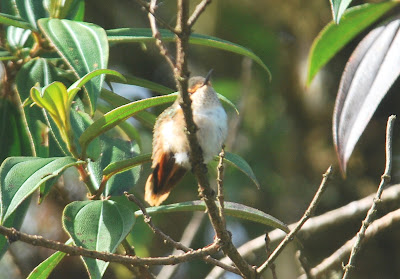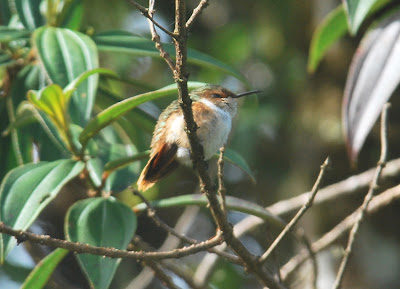As announced previously, in our last trip to the highlands of the Ngöbe-Buglé reservation, in the former eastern Chiriquí province, we saw many Selasphorus hummingbirds... all of them, but one, female-plumaged birds. In fact, they were not rare... we saw different individuals in eight different sites every day of our trip, including right at the cabin where we stayed. So, what is the problem? Well, the problem is that two different species occur in those mountains (well, at least in Cerro Santiago)... and the females are VERY hard to tell apart... you will see what I mean. It is frustrating... in my first trip to Cerro Santiago, we saw several females... but we were not able to ID them since we never had good views of the tail patterns (check the comments of that post).
The first chance I got to photograph these hummingbirds was in the trail going down into the Caribbean slope, along the Ngwoini creek (at about 1500 meters above sea level, and several kilometers to the east of Cerro Santiago and Cerro Colorado, so supposedly well into the Glow-throated Hummingbird distribution). We saw there the female pictured above. Notice the very pale underparts (thought little overexposed). We also saw a female-plumaged bird by the creek that, after checking the photos, turned out to be a young male (notice the feathers in the throat). No color in these feathers was evident in the field.
The third day, we visited the main road along the slopes of the Cerro Santiago massif, at about 1700 meters above sea level). There, we were able to have looks at eye level of the canopy of some flowering trees attracting Selasphorus hummingbirds, including this female.
Notice that there was no evidence of immaturity in this individual (no rufous edge to the feathers of the back) and the white underparts, including the belly and undertail coverts. One of the available references (Ridgely & Gwynne 1976 and subsequent editions) states that the female Glow-throated is paler below than the female Scintillant, but others (Wetmore 1968, Angehr & Dean 2010) fail to describe this. Wetmore describe for both Scintillant and Glow-throated Hummingbirds the white lateral tufts, present in this individual, a mark shared with the female Magenta-throated Woodstar.
As you can see, we got great looks of the tail pattern. Notice that most of the right rectrice #1 (the pair of central feathers in the tail) and all the left rectrice #1 are covered by the left rectrice #2. Also, notice that both rectrices #2 have a clear green margin above the black subterminal band... but most important... notice the rufous (not buff) tip of the central rectrice (there is a better photo of the tail pattern in Bill Adsett's report of this trip to Xenornis). Why is this important? Ridgely & Gwynne also states that the female Glow-throated Hummingbird have rufous tail tips to the central (green) rectrices, absent in the female Scintillant Hummingbird. In fact, the most comprehensive work on these birds, "Systematics of southern forms of Selasphorus" by F. Gary Stiles (1982) also shows this difference in a diagram comparing tail patterns of adult males and females Glow-throated and Scintillant Hummingbirds.
 |
| sc = Scintillant Hummingbird; a = Glow-throated Hummingbird. |
Some say that the females can't be identified in the field, but I think we have a strong case here. The truth is that it is better to have good looks of adult males with glittering gorgets, and we did it! Close to the time to leave the site, I saw a male Selasphorus flying above the canopy of a distant tree... and for a fraction of second it turned its head to me, showing a glittering mid red, rounded gorget! We stayed in the site for a while, but we only managed to see the male a couple of times, always in the move and for just few seconds. The next day, Charles Davies went to the site and found the perch that the male was using, and got some good photos (fell free to enlarge the next photos).
 |
| Copyright Charles Davies, used with permission. |
 |
| Copyright Charles Davies, used with permission. |
Notice the color of the gorget. Certainly, it is not orange or golden-orange as we are used for Scintillant Hummingbird. Also notice the tail... it is mostly BLACK! The color of the gorget may vary according to the light, distance and angle... but the tail color is a VERY good mark (notice Stiles' diagram again). Also, notice the gorget shape. All the adults Selasphorus males have erectable gorgets, but the shape and length of the lateral "wings" differ from one species to another, as explained in another diagram of Stiles' work. Compare Charles pictures with this diagram and tell me which one fix better?
 |
| Gorget shape (typical form with variants shown in dotted lines). Sc = Scintillant Hummingbird; a = Glow-throated Hummingbird; si, f, t = simoni, flammula and torridus Volcano Hummingbirds |
We are calling this individual a typical adult male Glow-throated Hummingbird... and I finally have the pleasure to include this species in my Life List (after three years).
















No comments:
Post a Comment